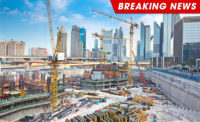How Building Envelope Firms Are Using Technology to Overcome Labor Shortages
Building enclosure professionals are turning to digital tools, AI and mobile field technology to meet rising performance expectations with leaner teams

Image courtesy of Bluebeam
The construction industry isn’t just short on people—it’s short on time, expertise and margin for error. And nowhere is that pressure more acute than in building enclosures, where one missed detail can mean catastrophic leaks, energy inefficiency or expensive rework.
As workforce constraints deepen, firms responsible for designing and delivering high-performance façades, curtain walls and envelope systems are being asked to do more with less. The stakes are rising—from tighter building codes and decarbonization goals to increased complexity in materials and detailing. Yet the available labor pool is aging, shrinking and struggling to keep pace.
Technology is quickly becoming the great equalizer. Building envelope consultants, architects and contractors are adopting digital tools to stretch their resources, eliminate communication breakdowns and ensure quality doesn't slip through the cracks—literally.
A Unique Pressure Point in the Labor Crisis
While the broader construction industry added 13,000 jobs in March 2025, labor demand continues to outpace supply, especially for specialty trades and envelope experts.
According to the National Association of Home Builders, nearly 1 in 5 construction workers are aged 55 or older—a share that has steadily increased over the past decade. At the same time, the percentage of workers aged 25 to 54 has declined, reflecting a concerning drop in younger individuals entering the trades.
These demographic shifts, as detailed in the Spring 2024 Construction Labor Market Report, point to a looming wave of retirements and an insufficient training pipeline to replenish the skilled workforce.
For building enclosure professionals, this shortage poses a serious risk. Enclosure systems must balance thermal performance, air and moisture control, material integration and structural coordination—all while meeting increasingly rigorous sustainability and resiliency standards.
Mistakes in sequencing, installation or communication don’t just cost time; they compromise building performance.
Digital Collaboration: Doing More with the Team You Have
To maintain project momentum and design integrity, envelope professionals are turning to digital collaboration platforms. Tools that centralize submittals, RFIs, markups and reviews in a shared digital environment are helping to minimize version confusion and shorten feedback loops.
This shift from static PDFs and email attachments to cloud-based markup and review enables teams to catch issues earlier, coordinate detailing more effectively and reduce rework—even when working with smaller teams. Real-time access to annotated documents also improves communication between field crews, consultants and fabricators, ensuring fewer disconnects across project phases.
Just as importantly, centralized workflows help preserve institutional knowledge, standardizing processes, housing key markups and documentation, and making it easier to train and onboard new team members as staffing fluctuates.
Field Technology That Powers Real-Time QA/QC
As on-site supervision becomes harder to staff, envelope teams are leveraging field technology to ensure quality doesn’t suffer. Tablets and mobile apps allow field workers to pull up the latest drawings, flag issues, tag progress photos and log observations, without needing to leave the jobsite or wait for paper-based reviews.
Many construction projects are now using QR code-based documentation, allowing teams to scan labels on windows or wall assemblies to instantly access specs, installation guides or warranty information, streamlining field communication and recordkeeping. For large-scale or high-rise projects, drone imagery and photogrammetry are streamlining façade inspections, helping teams validate work, spot issues early and reduce field time by as much as 70%.
Streamlining Workflows and Reducing Rework
Across the industry, building enclosure professionals are reporting meaningful gains in efficiency by integrating digital tools into their workflows. Firms have cut turnaround times for shop drawing reviews, improved traceability in issue resolution and reduced duplication across project stakeholders.
On the jobsite, mobile field tools are improving coordination across trades, enabling real-time reporting and allowing teams to track installation quality more effectively. By removing paper-based bottlenecks and centralizing updates, firms are minimizing project delays and better managing resource constraints.
While the specific tools may vary, the trend is clear: digital transformation is no longer optional—it’s essential.
The Long Game: Training and Standardization
Technology adoption is only one piece of the puzzle. Many envelope-focused firms are embedding tech training into onboarding and apprenticeship programs to ensure workers can operate in digital environments from day one. These programs combine core trade skills with software proficiency, helping new hires become productive more quickly, even in the absence of veteran mentors.
Firms are also working to standardize how digital tools are deployed across teams and projects. This helps reduce variability, improves project-to-project consistency and allows companies to scale their knowledge across a wider labor pool with less friction.
The construction labor shortage shows no signs of easing—but that doesn’t mean quality or performance should suffer. For building envelope professionals, digital collaboration and mobile field technology are proving to be powerful levers for navigating workforce constraints while meeting today’s ambitious design and sustainability targets.
As projects grow in complexity and the labor market remains tight, firms that invest in scalable, tech-driven solutions will be better positioned to deliver high-performance enclosures—on time, on budget and without compromise.
Looking for a reprint of this article?
From high-res PDFs to custom plaques, order your copy today!
-(1)-(002).jpg?height=96&t=1744635340&width=96)




.png?height=200&t=1741113237&width=200)
